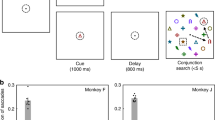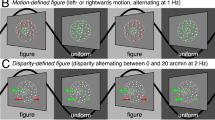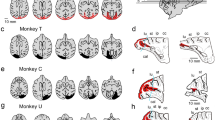Abstract
THE primate visual system has a remarkable capability for recognizing objects irrespective of the multitude of images they form on the retinal surface by virtue of changes in size, perspective, contrast, colour and partial obstruction by other stimuli in the visual scene. There is increasing evidence that this remarkable capacity is brought about by processes that occur earlier in the visual system than had previously been thought1-14. Here I show that after ablation of area V4 in the rhesus monkey, major deficits arise in the recognition of objects that have been transformed in size, in the degree of occlusion, and in the amount of contour information provided. The ability to detect these objects when presented individually was unaffected by these lesions.
This is a preview of subscription content, access via your institution
Access options
Subscribe to this journal
Receive 51 print issues and online access
$199.00 per year
only $3.90 per issue
Buy this article
- Purchase on Springer Link
- Instant access to full article PDF
Prices may be subject to local taxes which are calculated during checkout
Similar content being viewed by others
References
Desimone, R. & Schein, S. J. J. Neurophysiol. 57, 835–868 (1987).
Felleman, D. J. & Van Essen, D. C. Cerebral Cortex 1, 1–47 (1991).
Ferrera, V. P., Nealy, T. A. & Maunsell, J. H. R. Nature 358, 756–758 (1992).
Haenny, P. E., Maunsell, J. H. R. & Schiller, P. H. Expl Brain Res. 69, 245–259 (1988).
Haenny, P. E. & Schiller, P. H. Expl Brain Res. 69, 225–244 (1988).
Heywood, C. A. & Cowey, A. J. Neurosci. 7, 2601–2617 (1987).
Heywood, C. A., Gadotti, A. & Cowey, A. J. Neurosci. 12, 4056–4065 (1992).
Moran, J. & Desimone, R. Science 229, 782–784 (1985).
Motter, B. C. J. Neurosci. 14, 2190–2199 (1994).
Schiller, P. H. Behav. Brain Res. (in the press).
Schiller, P. H. Visual Neurosci. 10, 717–746 (1993).
Schiller, P. H. & Lee, K.-M. Science 251, 1251–1253 (1991).
Schiller, P. H. & Logothetis, N. K. Trends Neurosci. 13, 392–398 (1990).
Schiller, P. H., Logothetis, N. K. & Charles, E. R. Visual Neurosci. 5, 321–346 (1990).
Weiskrantz, L. & Saunders, R. C. Brain 107, 1033–1072 (1984).
Walsh, V., Butler, S. R., Carden, D. & Kulikowski, J. J. Behav. Brain Res. 50, 115–126 (1992).
Hubel, D. H. & Wiesel, T. N. Nature 225, 41–42 (1970).
Livingstone, M. S. & Hubel, D. H. Science 240, 740–749 (1988).
Zeki, S. M. Brain Res. 53, 422–427 (1973).
Zeki, S. M. Nature 284, 412–418 (1980).
Author information
Authors and Affiliations
Rights and permissions
About this article
Cite this article
Schiller, P. Effect of lesions in visual cortical area V4 on the recognition of transformed objects. Nature 376, 342–344 (1995). https://doi.org/10.1038/376342a0
Received:
Accepted:
Issue Date:
DOI: https://doi.org/10.1038/376342a0
This article is cited by
-
The role of prefrontal cortex in the control of feature attention in area V4
Nature Communications (2019)
-
Responses of neurons of the extrastriate cortex of the cat brain to moving stimuli of different forms
Neurophysiology (2006)
Comments
By submitting a comment you agree to abide by our Terms and Community Guidelines. If you find something abusive or that does not comply with our terms or guidelines please flag it as inappropriate.



